Roehampton University MBA: Job Satisfaction and Employee Performance
VerifiedAdded on 2020/03/13
|30
|7496
|212
Report
AI Summary
This report, prepared for a Roehampton University MBA program, investigates the relationship between job satisfaction, employee motivation, and employee performance within Swiss companies. The research explores the impact of various factors, including employee-manager communication, leadership styles, employee engagement, training and development opportunities, and rewards and remuneration policies. The study utilizes primary data collected through surveys and interviews to determine the extent to which job satisfaction and motivation correlate with employee performance. The report delves into relevant theories such as Herzberg's Two-Factor Theory, and examines the significance of job security, training, and rewards as key drivers of employee satisfaction and motivation. The research aims to identify the specific factors that influence employee motivation and satisfaction, and how these factors ultimately affect employee performance. The study also highlights the research gaps in the existing literature, particularly the lack of geographically specific studies, and aims to provide insights into how companies can improve employee satisfaction, motivation, and performance, ultimately contributing to enhanced organizational outcomes.
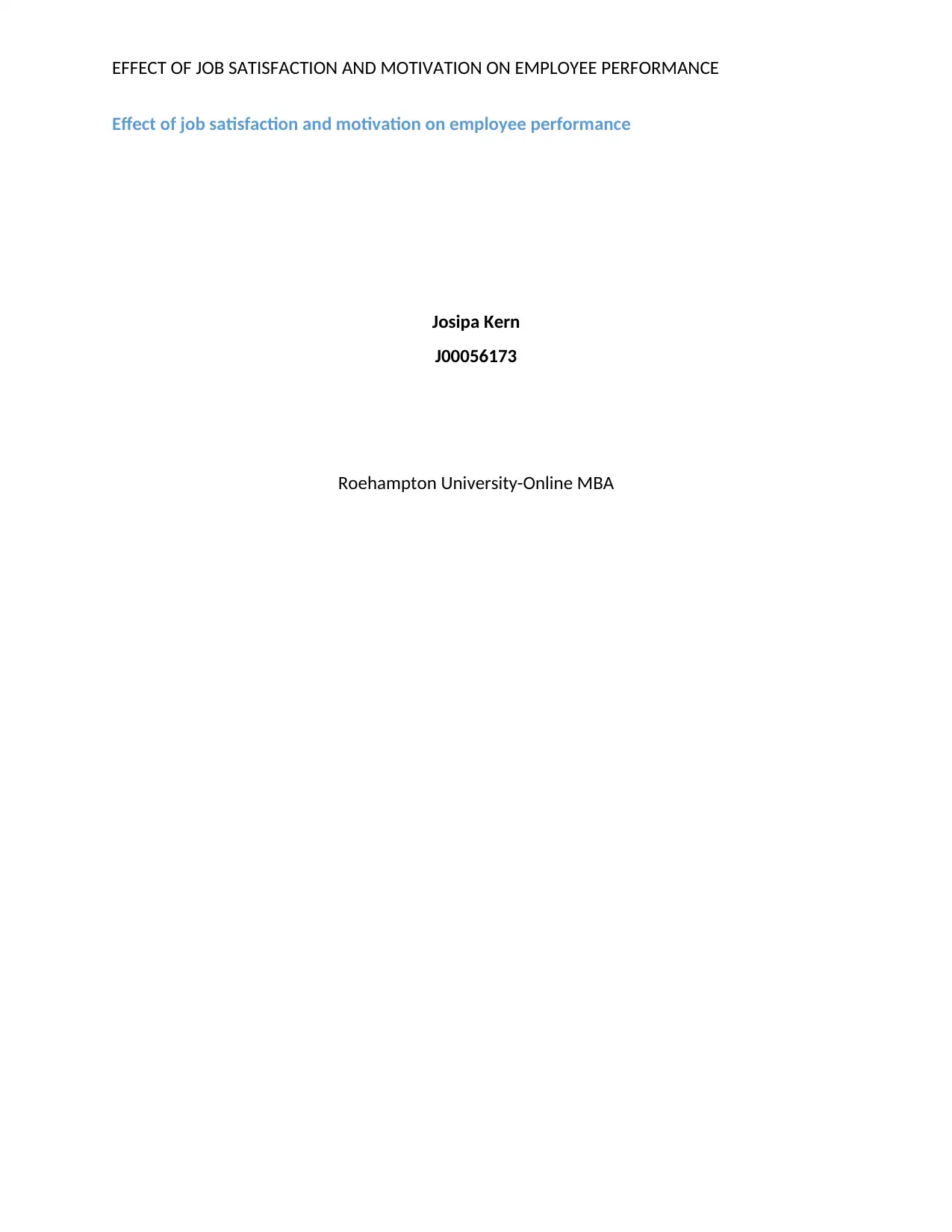
EFFECT OF JOB SATISFACTION AND MOTIVATION ON EMPLOYEE PERFORMANCE
Effect of job satisfaction and motivation on employee performance
Josipa Kern
J00056173
Roehampton University-Online MBA
Effect of job satisfaction and motivation on employee performance
Josipa Kern
J00056173
Roehampton University-Online MBA
Paraphrase This Document
Need a fresh take? Get an instant paraphrase of this document with our AI Paraphraser
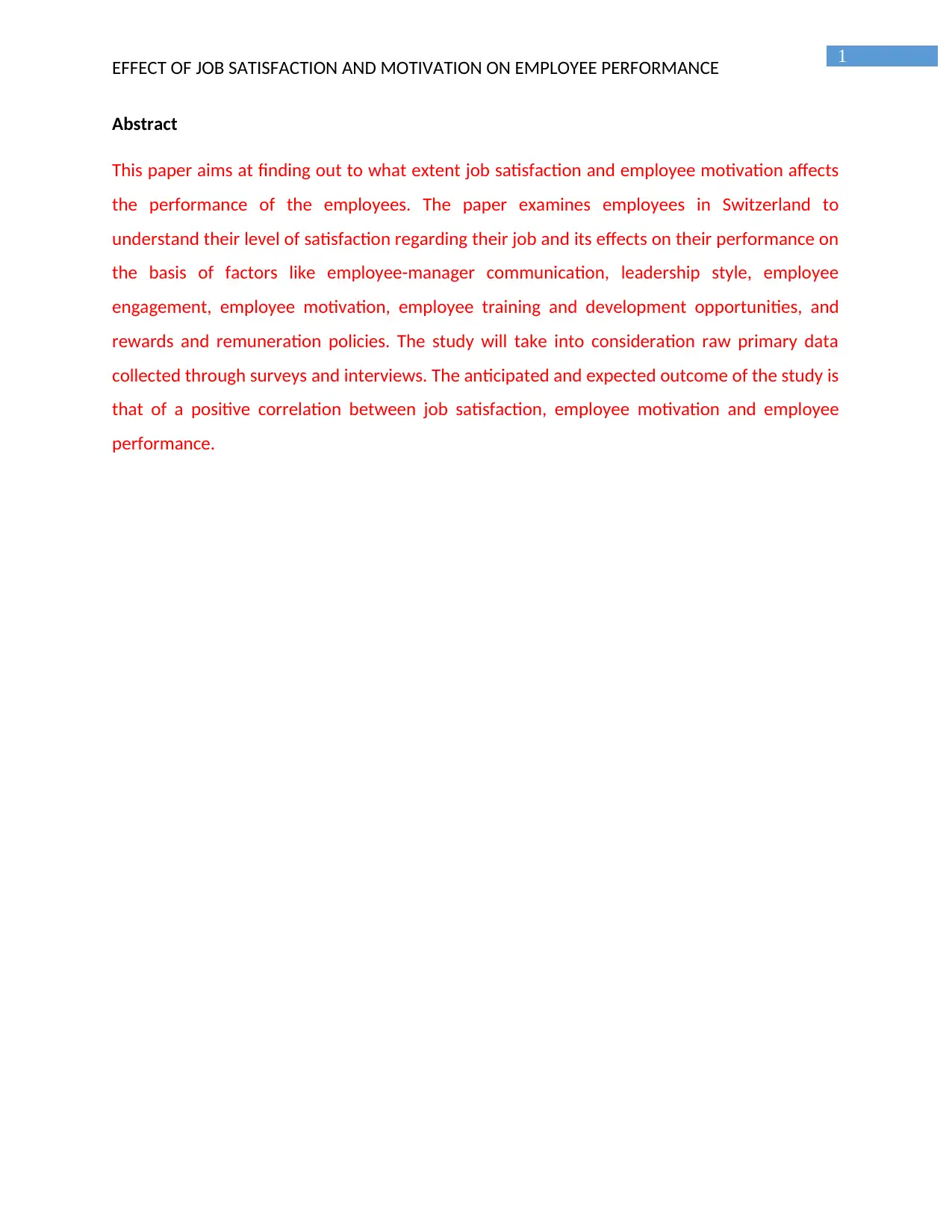
1
EFFECT OF JOB SATISFACTION AND MOTIVATION ON EMPLOYEE PERFORMANCE
Abstract
This paper aims at finding out to what extent job satisfaction and employee motivation affects
the performance of the employees. The paper examines employees in Switzerland to
understand their level of satisfaction regarding their job and its effects on their performance on
the basis of factors like employee-manager communication, leadership style, employee
engagement, employee motivation, employee training and development opportunities, and
rewards and remuneration policies. The study will take into consideration raw primary data
collected through surveys and interviews. The anticipated and expected outcome of the study is
that of a positive correlation between job satisfaction, employee motivation and employee
performance.
EFFECT OF JOB SATISFACTION AND MOTIVATION ON EMPLOYEE PERFORMANCE
Abstract
This paper aims at finding out to what extent job satisfaction and employee motivation affects
the performance of the employees. The paper examines employees in Switzerland to
understand their level of satisfaction regarding their job and its effects on their performance on
the basis of factors like employee-manager communication, leadership style, employee
engagement, employee motivation, employee training and development opportunities, and
rewards and remuneration policies. The study will take into consideration raw primary data
collected through surveys and interviews. The anticipated and expected outcome of the study is
that of a positive correlation between job satisfaction, employee motivation and employee
performance.
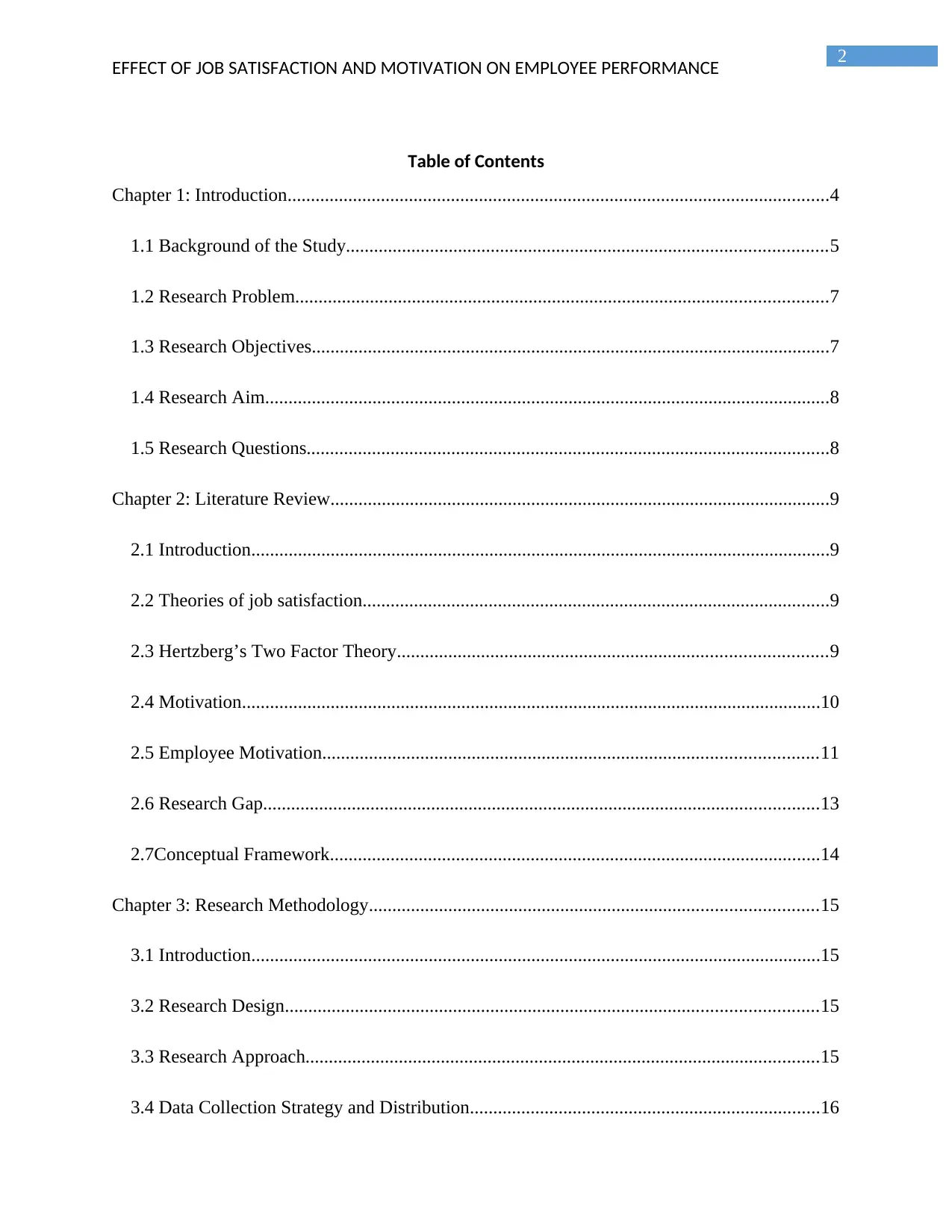
2
EFFECT OF JOB SATISFACTION AND MOTIVATION ON EMPLOYEE PERFORMANCE
Table of Contents
Chapter 1: Introduction....................................................................................................................4
1.1 Background of the Study.......................................................................................................5
1.2 Research Problem..................................................................................................................7
1.3 Research Objectives...............................................................................................................7
1.4 Research Aim.........................................................................................................................8
1.5 Research Questions................................................................................................................8
Chapter 2: Literature Review...........................................................................................................9
2.1 Introduction............................................................................................................................9
2.2 Theories of job satisfaction....................................................................................................9
2.3 Hertzberg’s Two Factor Theory............................................................................................9
2.4 Motivation............................................................................................................................10
2.5 Employee Motivation..........................................................................................................11
2.6 Research Gap.......................................................................................................................13
2.7Conceptual Framework.........................................................................................................14
Chapter 3: Research Methodology................................................................................................15
3.1 Introduction..........................................................................................................................15
3.2 Research Design..................................................................................................................15
3.3 Research Approach..............................................................................................................15
3.4 Data Collection Strategy and Distribution...........................................................................16
EFFECT OF JOB SATISFACTION AND MOTIVATION ON EMPLOYEE PERFORMANCE
Table of Contents
Chapter 1: Introduction....................................................................................................................4
1.1 Background of the Study.......................................................................................................5
1.2 Research Problem..................................................................................................................7
1.3 Research Objectives...............................................................................................................7
1.4 Research Aim.........................................................................................................................8
1.5 Research Questions................................................................................................................8
Chapter 2: Literature Review...........................................................................................................9
2.1 Introduction............................................................................................................................9
2.2 Theories of job satisfaction....................................................................................................9
2.3 Hertzberg’s Two Factor Theory............................................................................................9
2.4 Motivation............................................................................................................................10
2.5 Employee Motivation..........................................................................................................11
2.6 Research Gap.......................................................................................................................13
2.7Conceptual Framework.........................................................................................................14
Chapter 3: Research Methodology................................................................................................15
3.1 Introduction..........................................................................................................................15
3.2 Research Design..................................................................................................................15
3.3 Research Approach..............................................................................................................15
3.4 Data Collection Strategy and Distribution...........................................................................16
⊘ This is a preview!⊘
Do you want full access?
Subscribe today to unlock all pages.

Trusted by 1+ million students worldwide
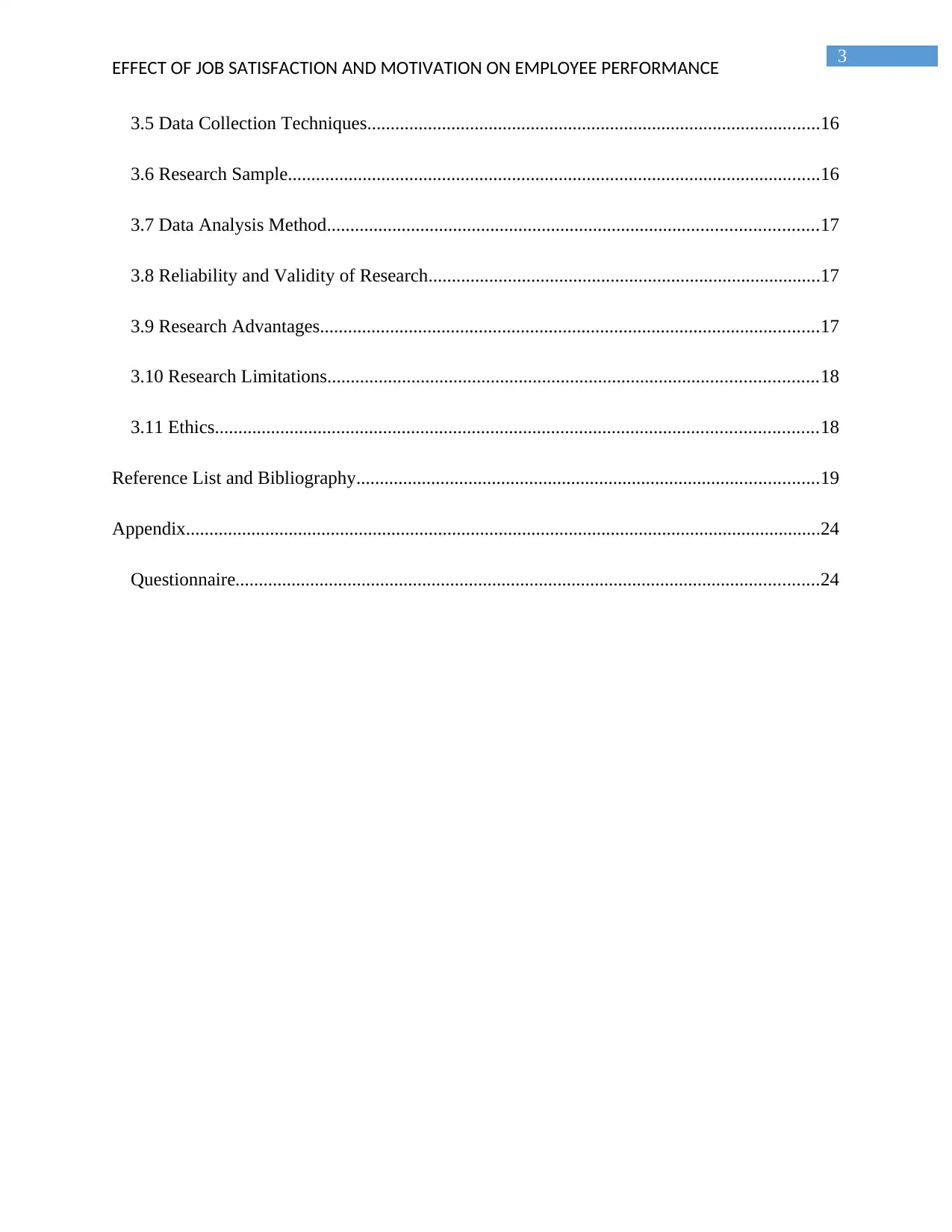
3
EFFECT OF JOB SATISFACTION AND MOTIVATION ON EMPLOYEE PERFORMANCE
3.5 Data Collection Techniques.................................................................................................16
3.6 Research Sample..................................................................................................................16
3.7 Data Analysis Method.........................................................................................................17
3.8 Reliability and Validity of Research....................................................................................17
3.9 Research Advantages...........................................................................................................17
3.10 Research Limitations.........................................................................................................18
3.11 Ethics.................................................................................................................................18
Reference List and Bibliography...................................................................................................19
Appendix........................................................................................................................................24
Questionnaire.............................................................................................................................24
EFFECT OF JOB SATISFACTION AND MOTIVATION ON EMPLOYEE PERFORMANCE
3.5 Data Collection Techniques.................................................................................................16
3.6 Research Sample..................................................................................................................16
3.7 Data Analysis Method.........................................................................................................17
3.8 Reliability and Validity of Research....................................................................................17
3.9 Research Advantages...........................................................................................................17
3.10 Research Limitations.........................................................................................................18
3.11 Ethics.................................................................................................................................18
Reference List and Bibliography...................................................................................................19
Appendix........................................................................................................................................24
Questionnaire.............................................................................................................................24
Paraphrase This Document
Need a fresh take? Get an instant paraphrase of this document with our AI Paraphraser
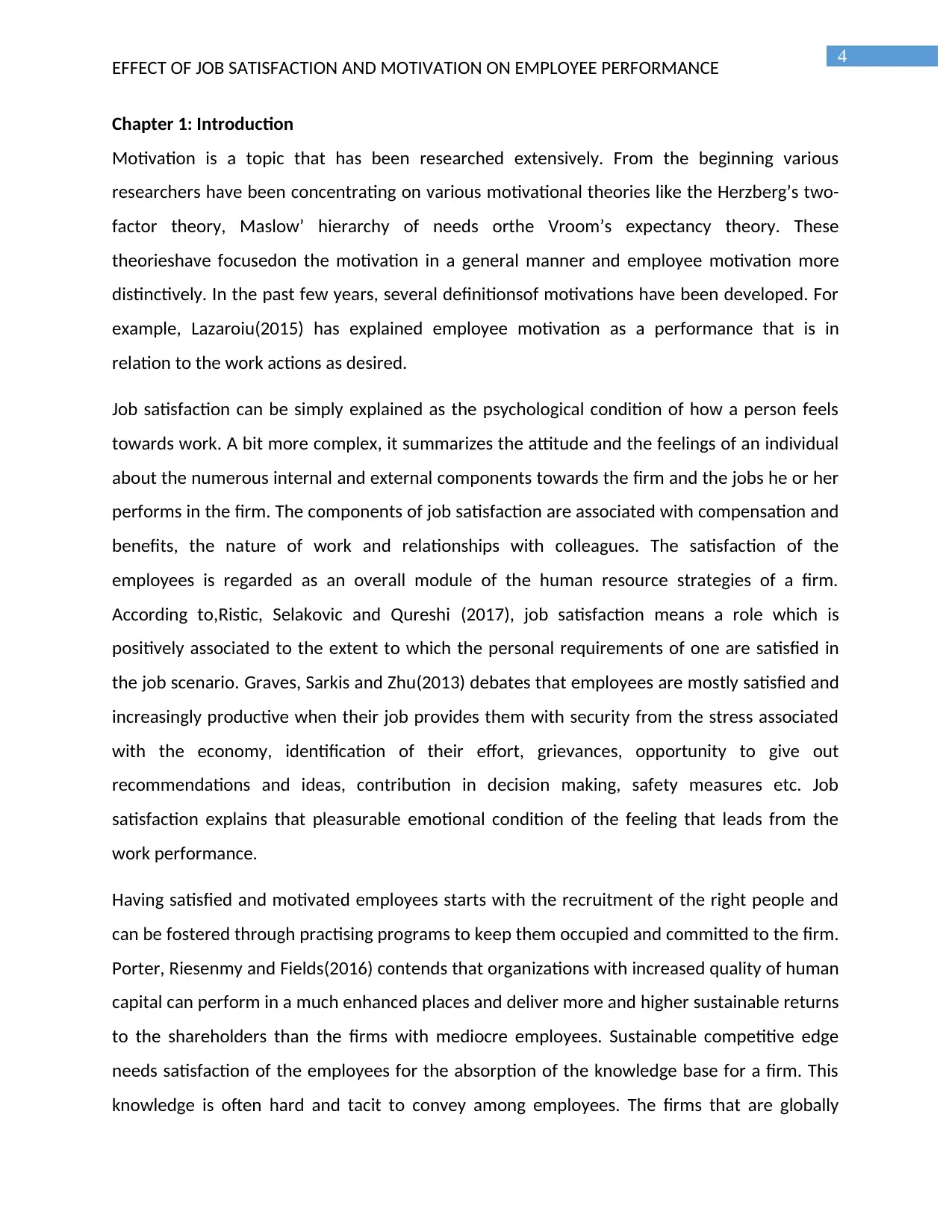
4
EFFECT OF JOB SATISFACTION AND MOTIVATION ON EMPLOYEE PERFORMANCE
Chapter 1: Introduction
Motivation is a topic that has been researched extensively. From the beginning various
researchers have been concentrating on various motivational theories like the Herzberg’s two-
factor theory, Maslow’ hierarchy of needs orthe Vroom’s expectancy theory. These
theorieshave focusedon the motivation in a general manner and employee motivation more
distinctively. In the past few years, several definitionsof motivations have been developed. For
example, Lazaroiu(2015) has explained employee motivation as a performance that is in
relation to the work actions as desired.
Job satisfaction can be simply explained as the psychological condition of how a person feels
towards work. A bit more complex, it summarizes the attitude and the feelings of an individual
about the numerous internal and external components towards the firm and the jobs he or her
performs in the firm. The components of job satisfaction are associated with compensation and
benefits, the nature of work and relationships with colleagues. The satisfaction of the
employees is regarded as an overall module of the human resource strategies of a firm.
According to,Ristic, Selakovic and Qureshi (2017), job satisfaction means a role which is
positively associated to the extent to which the personal requirements of one are satisfied in
the job scenario. Graves, Sarkis and Zhu(2013) debates that employees are mostly satisfied and
increasingly productive when their job provides them with security from the stress associated
with the economy, identification of their effort, grievances, opportunity to give out
recommendations and ideas, contribution in decision making, safety measures etc. Job
satisfaction explains that pleasurable emotional condition of the feeling that leads from the
work performance.
Having satisfied and motivated employees starts with the recruitment of the right people and
can be fostered through practising programs to keep them occupied and committed to the firm.
Porter, Riesenmy and Fields(2016) contends that organizations with increased quality of human
capital can perform in a much enhanced places and deliver more and higher sustainable returns
to the shareholders than the firms with mediocre employees. Sustainable competitive edge
needs satisfaction of the employees for the absorption of the knowledge base for a firm. This
knowledge is often hard and tacit to convey among employees. The firms that are globally
EFFECT OF JOB SATISFACTION AND MOTIVATION ON EMPLOYEE PERFORMANCE
Chapter 1: Introduction
Motivation is a topic that has been researched extensively. From the beginning various
researchers have been concentrating on various motivational theories like the Herzberg’s two-
factor theory, Maslow’ hierarchy of needs orthe Vroom’s expectancy theory. These
theorieshave focusedon the motivation in a general manner and employee motivation more
distinctively. In the past few years, several definitionsof motivations have been developed. For
example, Lazaroiu(2015) has explained employee motivation as a performance that is in
relation to the work actions as desired.
Job satisfaction can be simply explained as the psychological condition of how a person feels
towards work. A bit more complex, it summarizes the attitude and the feelings of an individual
about the numerous internal and external components towards the firm and the jobs he or her
performs in the firm. The components of job satisfaction are associated with compensation and
benefits, the nature of work and relationships with colleagues. The satisfaction of the
employees is regarded as an overall module of the human resource strategies of a firm.
According to,Ristic, Selakovic and Qureshi (2017), job satisfaction means a role which is
positively associated to the extent to which the personal requirements of one are satisfied in
the job scenario. Graves, Sarkis and Zhu(2013) debates that employees are mostly satisfied and
increasingly productive when their job provides them with security from the stress associated
with the economy, identification of their effort, grievances, opportunity to give out
recommendations and ideas, contribution in decision making, safety measures etc. Job
satisfaction explains that pleasurable emotional condition of the feeling that leads from the
work performance.
Having satisfied and motivated employees starts with the recruitment of the right people and
can be fostered through practising programs to keep them occupied and committed to the firm.
Porter, Riesenmy and Fields(2016) contends that organizations with increased quality of human
capital can perform in a much enhanced places and deliver more and higher sustainable returns
to the shareholders than the firms with mediocre employees. Sustainable competitive edge
needs satisfaction of the employees for the absorption of the knowledge base for a firm. This
knowledge is often hard and tacit to convey among employees. The firms that are globally
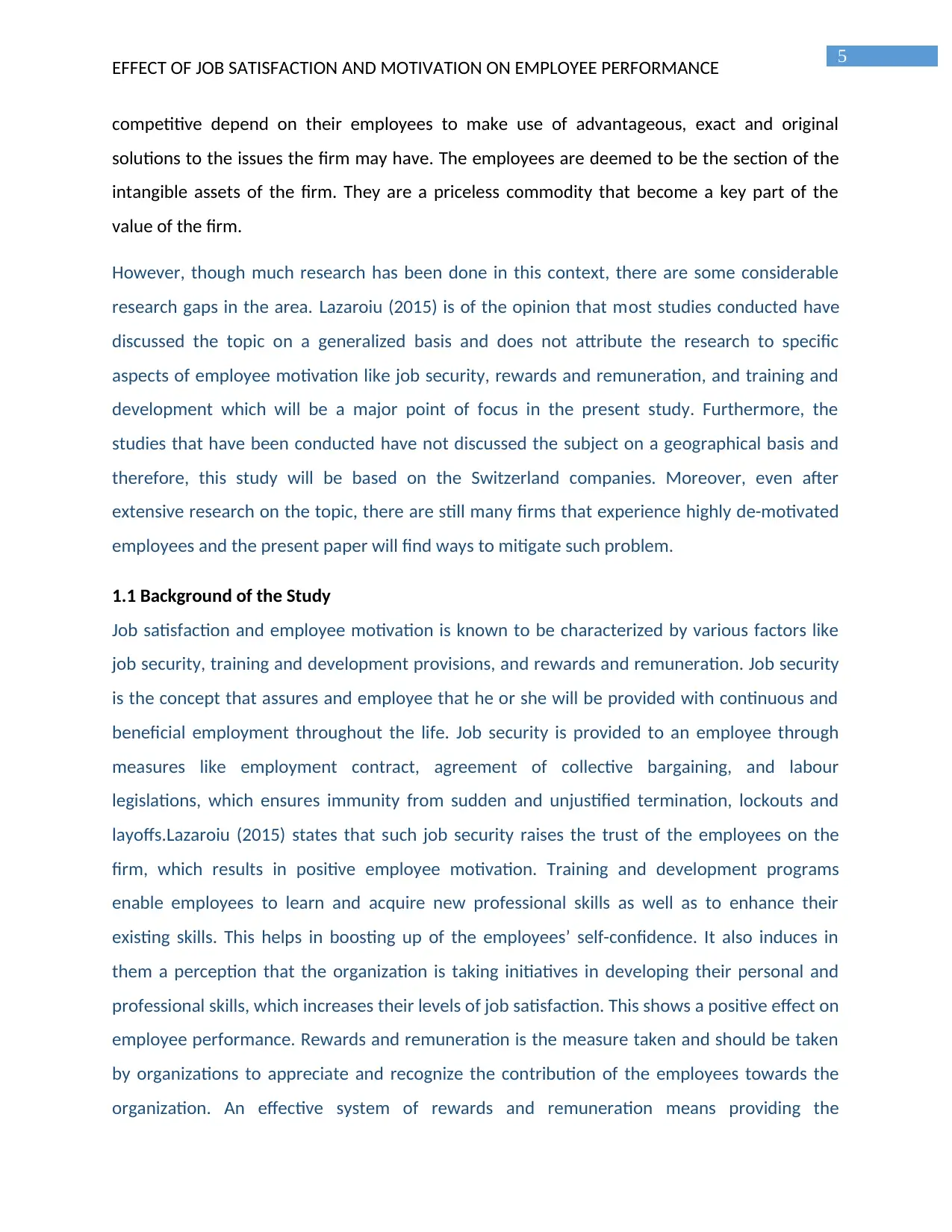
5
EFFECT OF JOB SATISFACTION AND MOTIVATION ON EMPLOYEE PERFORMANCE
competitive depend on their employees to make use of advantageous, exact and original
solutions to the issues the firm may have. The employees are deemed to be the section of the
intangible assets of the firm. They are a priceless commodity that become a key part of the
value of the firm.
However, though much research has been done in this context, there are some considerable
research gaps in the area. Lazaroiu (2015) is of the opinion that most studies conducted have
discussed the topic on a generalized basis and does not attribute the research to specific
aspects of employee motivation like job security, rewards and remuneration, and training and
development which will be a major point of focus in the present study. Furthermore, the
studies that have been conducted have not discussed the subject on a geographical basis and
therefore, this study will be based on the Switzerland companies. Moreover, even after
extensive research on the topic, there are still many firms that experience highly de-motivated
employees and the present paper will find ways to mitigate such problem.
1.1 Background of the Study
Job satisfaction and employee motivation is known to be characterized by various factors like
job security, training and development provisions, and rewards and remuneration. Job security
is the concept that assures and employee that he or she will be provided with continuous and
beneficial employment throughout the life. Job security is provided to an employee through
measures like employment contract, agreement of collective bargaining, and labour
legislations, which ensures immunity from sudden and unjustified termination, lockouts and
layoffs.Lazaroiu (2015) states that such job security raises the trust of the employees on the
firm, which results in positive employee motivation. Training and development programs
enable employees to learn and acquire new professional skills as well as to enhance their
existing skills. This helps in boosting up of the employees’ self-confidence. It also induces in
them a perception that the organization is taking initiatives in developing their personal and
professional skills, which increases their levels of job satisfaction. This shows a positive effect on
employee performance. Rewards and remuneration is the measure taken and should be taken
by organizations to appreciate and recognize the contribution of the employees towards the
organization. An effective system of rewards and remuneration means providing the
EFFECT OF JOB SATISFACTION AND MOTIVATION ON EMPLOYEE PERFORMANCE
competitive depend on their employees to make use of advantageous, exact and original
solutions to the issues the firm may have. The employees are deemed to be the section of the
intangible assets of the firm. They are a priceless commodity that become a key part of the
value of the firm.
However, though much research has been done in this context, there are some considerable
research gaps in the area. Lazaroiu (2015) is of the opinion that most studies conducted have
discussed the topic on a generalized basis and does not attribute the research to specific
aspects of employee motivation like job security, rewards and remuneration, and training and
development which will be a major point of focus in the present study. Furthermore, the
studies that have been conducted have not discussed the subject on a geographical basis and
therefore, this study will be based on the Switzerland companies. Moreover, even after
extensive research on the topic, there are still many firms that experience highly de-motivated
employees and the present paper will find ways to mitigate such problem.
1.1 Background of the Study
Job satisfaction and employee motivation is known to be characterized by various factors like
job security, training and development provisions, and rewards and remuneration. Job security
is the concept that assures and employee that he or she will be provided with continuous and
beneficial employment throughout the life. Job security is provided to an employee through
measures like employment contract, agreement of collective bargaining, and labour
legislations, which ensures immunity from sudden and unjustified termination, lockouts and
layoffs.Lazaroiu (2015) states that such job security raises the trust of the employees on the
firm, which results in positive employee motivation. Training and development programs
enable employees to learn and acquire new professional skills as well as to enhance their
existing skills. This helps in boosting up of the employees’ self-confidence. It also induces in
them a perception that the organization is taking initiatives in developing their personal and
professional skills, which increases their levels of job satisfaction. This shows a positive effect on
employee performance. Rewards and remuneration is the measure taken and should be taken
by organizations to appreciate and recognize the contribution of the employees towards the
organization. An effective system of rewards and remuneration means providing the
⊘ This is a preview!⊘
Do you want full access?
Subscribe today to unlock all pages.

Trusted by 1+ million students worldwide
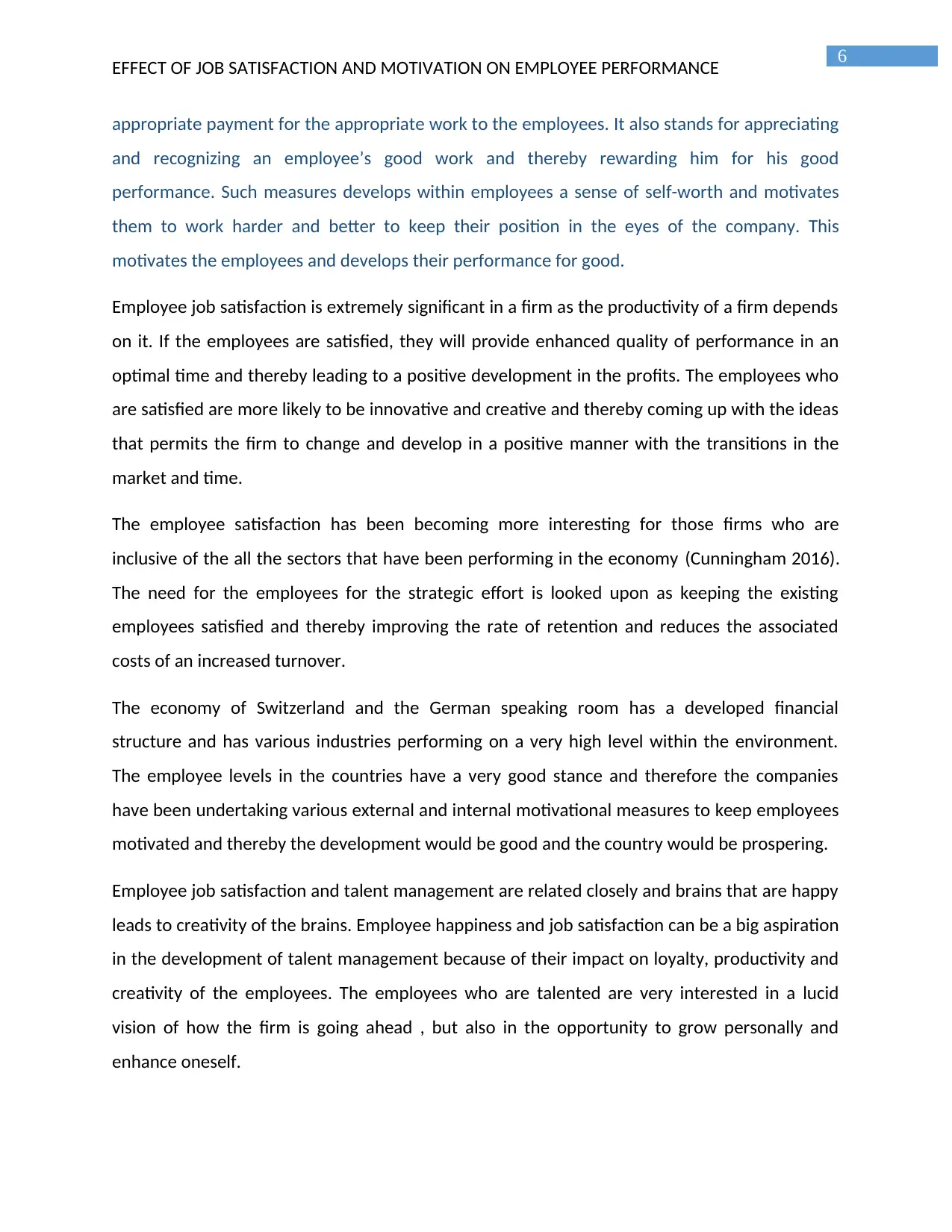
6
EFFECT OF JOB SATISFACTION AND MOTIVATION ON EMPLOYEE PERFORMANCE
appropriate payment for the appropriate work to the employees. It also stands for appreciating
and recognizing an employee’s good work and thereby rewarding him for his good
performance. Such measures develops within employees a sense of self-worth and motivates
them to work harder and better to keep their position in the eyes of the company. This
motivates the employees and develops their performance for good.
Employee job satisfaction is extremely significant in a firm as the productivity of a firm depends
on it. If the employees are satisfied, they will provide enhanced quality of performance in an
optimal time and thereby leading to a positive development in the profits. The employees who
are satisfied are more likely to be innovative and creative and thereby coming up with the ideas
that permits the firm to change and develop in a positive manner with the transitions in the
market and time.
The employee satisfaction has been becoming more interesting for those firms who are
inclusive of the all the sectors that have been performing in the economy (Cunningham 2016).
The need for the employees for the strategic effort is looked upon as keeping the existing
employees satisfied and thereby improving the rate of retention and reduces the associated
costs of an increased turnover.
The economy of Switzerland and the German speaking room has a developed financial
structure and has various industries performing on a very high level within the environment.
The employee levels in the countries have a very good stance and therefore the companies
have been undertaking various external and internal motivational measures to keep employees
motivated and thereby the development would be good and the country would be prospering.
Employee job satisfaction and talent management are related closely and brains that are happy
leads to creativity of the brains. Employee happiness and job satisfaction can be a big aspiration
in the development of talent management because of their impact on loyalty, productivity and
creativity of the employees. The employees who are talented are very interested in a lucid
vision of how the firm is going ahead , but also in the opportunity to grow personally and
enhance oneself.
EFFECT OF JOB SATISFACTION AND MOTIVATION ON EMPLOYEE PERFORMANCE
appropriate payment for the appropriate work to the employees. It also stands for appreciating
and recognizing an employee’s good work and thereby rewarding him for his good
performance. Such measures develops within employees a sense of self-worth and motivates
them to work harder and better to keep their position in the eyes of the company. This
motivates the employees and develops their performance for good.
Employee job satisfaction is extremely significant in a firm as the productivity of a firm depends
on it. If the employees are satisfied, they will provide enhanced quality of performance in an
optimal time and thereby leading to a positive development in the profits. The employees who
are satisfied are more likely to be innovative and creative and thereby coming up with the ideas
that permits the firm to change and develop in a positive manner with the transitions in the
market and time.
The employee satisfaction has been becoming more interesting for those firms who are
inclusive of the all the sectors that have been performing in the economy (Cunningham 2016).
The need for the employees for the strategic effort is looked upon as keeping the existing
employees satisfied and thereby improving the rate of retention and reduces the associated
costs of an increased turnover.
The economy of Switzerland and the German speaking room has a developed financial
structure and has various industries performing on a very high level within the environment.
The employee levels in the countries have a very good stance and therefore the companies
have been undertaking various external and internal motivational measures to keep employees
motivated and thereby the development would be good and the country would be prospering.
Employee job satisfaction and talent management are related closely and brains that are happy
leads to creativity of the brains. Employee happiness and job satisfaction can be a big aspiration
in the development of talent management because of their impact on loyalty, productivity and
creativity of the employees. The employees who are talented are very interested in a lucid
vision of how the firm is going ahead , but also in the opportunity to grow personally and
enhance oneself.
Paraphrase This Document
Need a fresh take? Get an instant paraphrase of this document with our AI Paraphraser
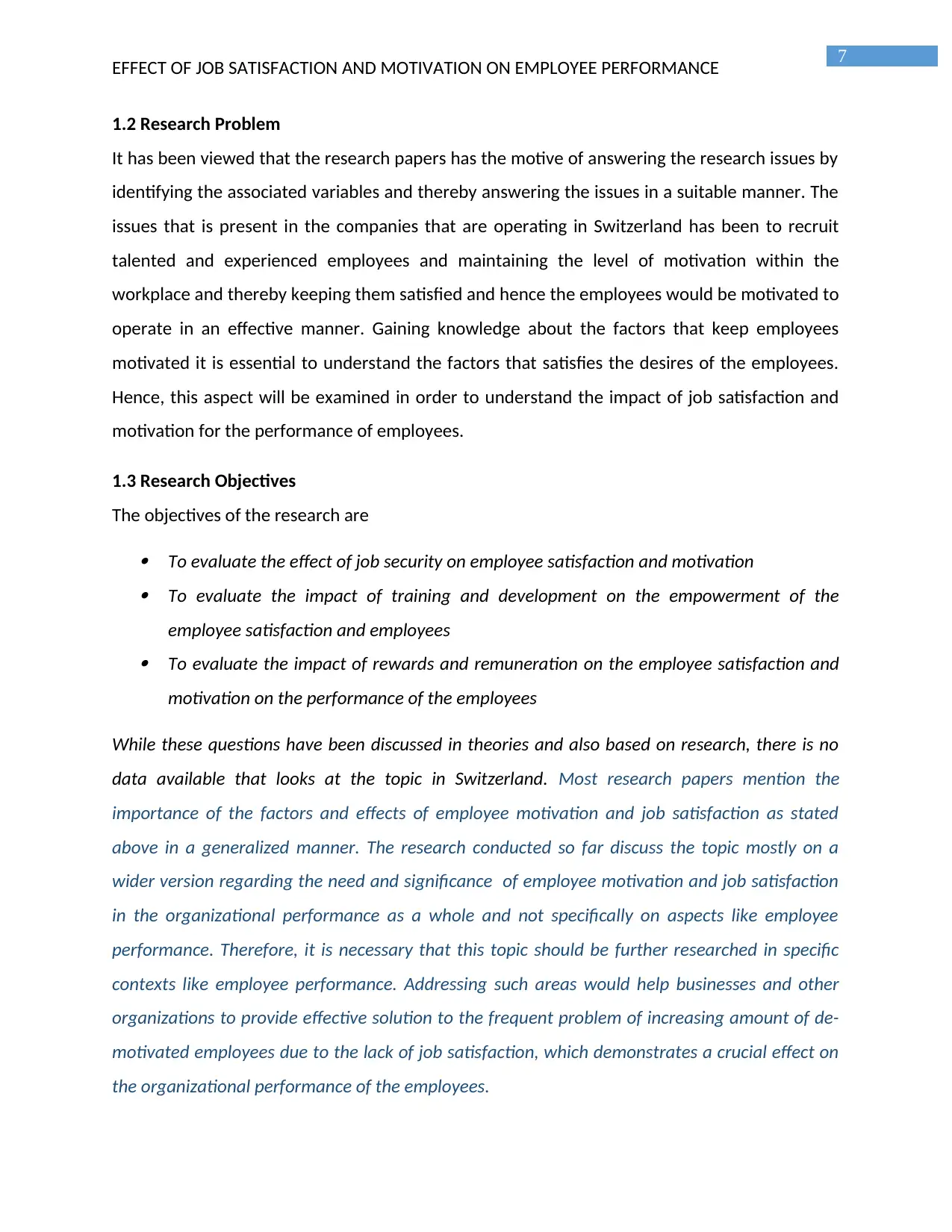
7
EFFECT OF JOB SATISFACTION AND MOTIVATION ON EMPLOYEE PERFORMANCE
1.2 Research Problem
It has been viewed that the research papers has the motive of answering the research issues by
identifying the associated variables and thereby answering the issues in a suitable manner. The
issues that is present in the companies that are operating in Switzerland has been to recruit
talented and experienced employees and maintaining the level of motivation within the
workplace and thereby keeping them satisfied and hence the employees would be motivated to
operate in an effective manner. Gaining knowledge about the factors that keep employees
motivated it is essential to understand the factors that satisfies the desires of the employees.
Hence, this aspect will be examined in order to understand the impact of job satisfaction and
motivation for the performance of employees.
1.3 Research Objectives
The objectives of the research are To evaluate the effect of job security on employee satisfaction and motivation To evaluate the impact of training and development on the empowerment of the
employee satisfaction and employees To evaluate the impact of rewards and remuneration on the employee satisfaction and
motivation on the performance of the employees
While these questions have been discussed in theories and also based on research, there is no
data available that looks at the topic in Switzerland. Most research papers mention the
importance of the factors and effects of employee motivation and job satisfaction as stated
above in a generalized manner. The research conducted so far discuss the topic mostly on a
wider version regarding the need and significance of employee motivation and job satisfaction
in the organizational performance as a whole and not specifically on aspects like employee
performance. Therefore, it is necessary that this topic should be further researched in specific
contexts like employee performance. Addressing such areas would help businesses and other
organizations to provide effective solution to the frequent problem of increasing amount of de-
motivated employees due to the lack of job satisfaction, which demonstrates a crucial effect on
the organizational performance of the employees.
EFFECT OF JOB SATISFACTION AND MOTIVATION ON EMPLOYEE PERFORMANCE
1.2 Research Problem
It has been viewed that the research papers has the motive of answering the research issues by
identifying the associated variables and thereby answering the issues in a suitable manner. The
issues that is present in the companies that are operating in Switzerland has been to recruit
talented and experienced employees and maintaining the level of motivation within the
workplace and thereby keeping them satisfied and hence the employees would be motivated to
operate in an effective manner. Gaining knowledge about the factors that keep employees
motivated it is essential to understand the factors that satisfies the desires of the employees.
Hence, this aspect will be examined in order to understand the impact of job satisfaction and
motivation for the performance of employees.
1.3 Research Objectives
The objectives of the research are To evaluate the effect of job security on employee satisfaction and motivation To evaluate the impact of training and development on the empowerment of the
employee satisfaction and employees To evaluate the impact of rewards and remuneration on the employee satisfaction and
motivation on the performance of the employees
While these questions have been discussed in theories and also based on research, there is no
data available that looks at the topic in Switzerland. Most research papers mention the
importance of the factors and effects of employee motivation and job satisfaction as stated
above in a generalized manner. The research conducted so far discuss the topic mostly on a
wider version regarding the need and significance of employee motivation and job satisfaction
in the organizational performance as a whole and not specifically on aspects like employee
performance. Therefore, it is necessary that this topic should be further researched in specific
contexts like employee performance. Addressing such areas would help businesses and other
organizations to provide effective solution to the frequent problem of increasing amount of de-
motivated employees due to the lack of job satisfaction, which demonstrates a crucial effect on
the organizational performance of the employees.
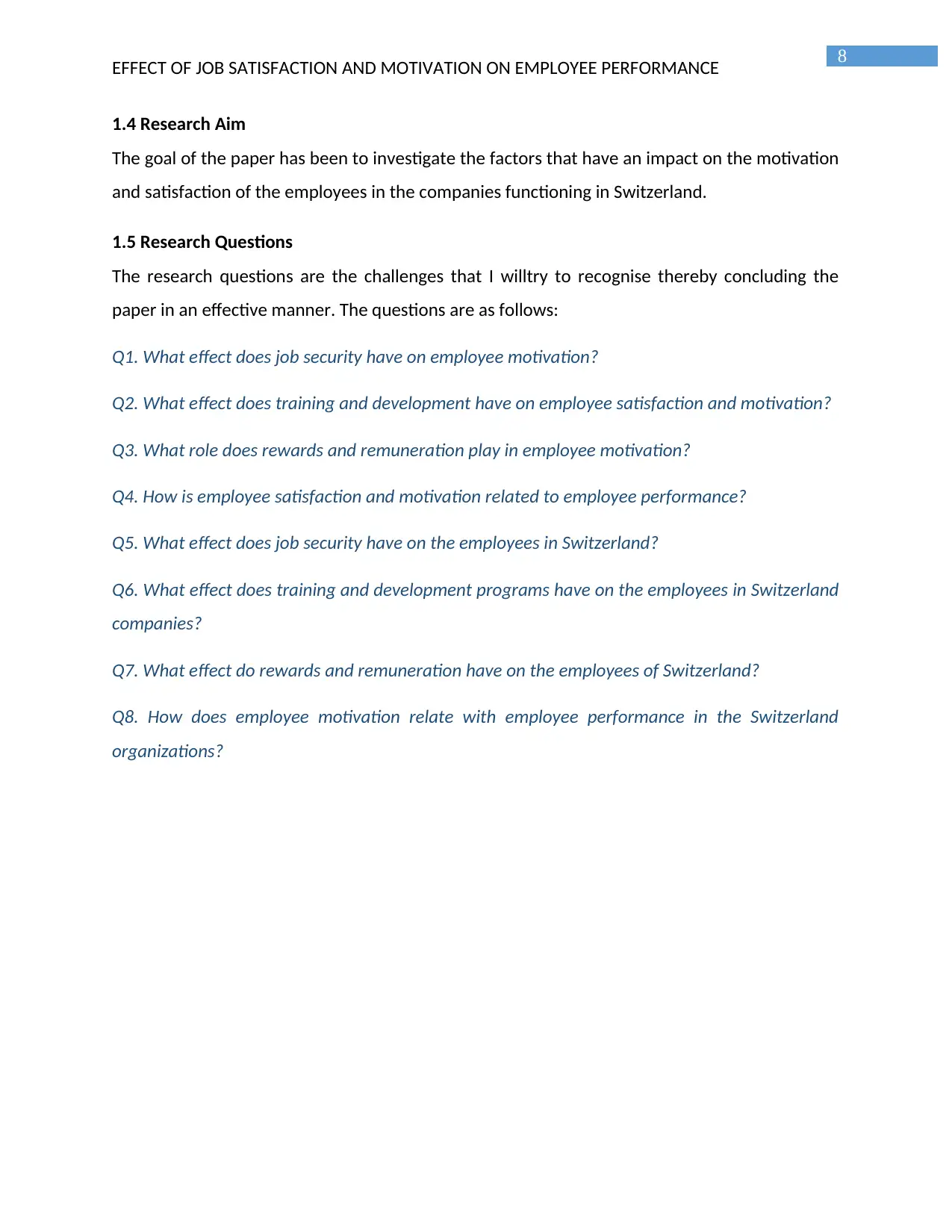
8
EFFECT OF JOB SATISFACTION AND MOTIVATION ON EMPLOYEE PERFORMANCE
1.4 Research Aim
The goal of the paper has been to investigate the factors that have an impact on the motivation
and satisfaction of the employees in the companies functioning in Switzerland.
1.5 Research Questions
The research questions are the challenges that I willtry to recognise thereby concluding the
paper in an effective manner. The questions are as follows:
Q1. What effect does job security have on employee motivation?
Q2. What effect does training and development have on employee satisfaction and motivation?
Q3. What role does rewards and remuneration play in employee motivation?
Q4. How is employee satisfaction and motivation related to employee performance?
Q5. What effect does job security have on the employees in Switzerland?
Q6. What effect does training and development programs have on the employees in Switzerland
companies?
Q7. What effect do rewards and remuneration have on the employees of Switzerland?
Q8. How does employee motivation relate with employee performance in the Switzerland
organizations?
EFFECT OF JOB SATISFACTION AND MOTIVATION ON EMPLOYEE PERFORMANCE
1.4 Research Aim
The goal of the paper has been to investigate the factors that have an impact on the motivation
and satisfaction of the employees in the companies functioning in Switzerland.
1.5 Research Questions
The research questions are the challenges that I willtry to recognise thereby concluding the
paper in an effective manner. The questions are as follows:
Q1. What effect does job security have on employee motivation?
Q2. What effect does training and development have on employee satisfaction and motivation?
Q3. What role does rewards and remuneration play in employee motivation?
Q4. How is employee satisfaction and motivation related to employee performance?
Q5. What effect does job security have on the employees in Switzerland?
Q6. What effect does training and development programs have on the employees in Switzerland
companies?
Q7. What effect do rewards and remuneration have on the employees of Switzerland?
Q8. How does employee motivation relate with employee performance in the Switzerland
organizations?
⊘ This is a preview!⊘
Do you want full access?
Subscribe today to unlock all pages.

Trusted by 1+ million students worldwide
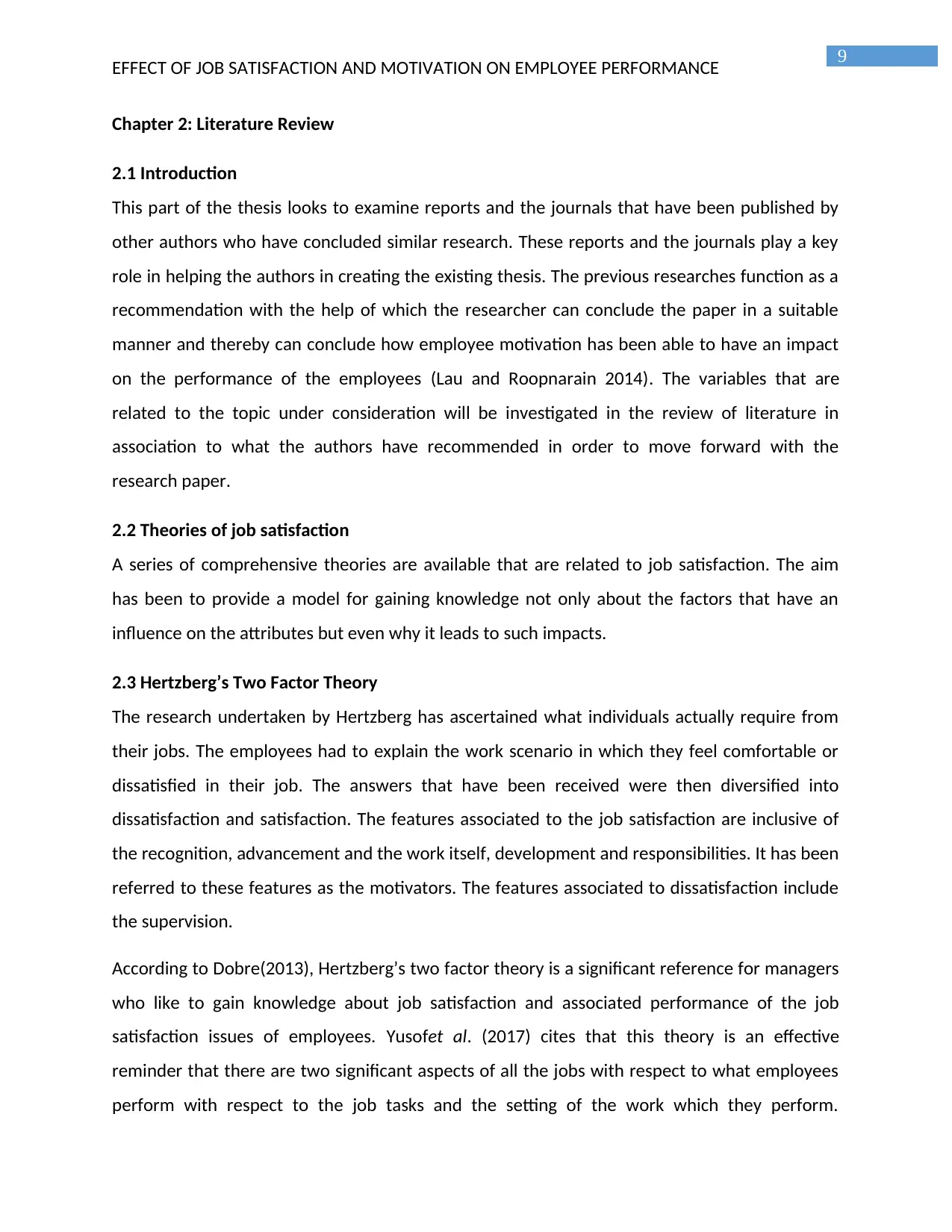
9
EFFECT OF JOB SATISFACTION AND MOTIVATION ON EMPLOYEE PERFORMANCE
Chapter 2: Literature Review
2.1 Introduction
This part of the thesis looks to examine reports and the journals that have been published by
other authors who have concluded similar research. These reports and the journals play a key
role in helping the authors in creating the existing thesis. The previous researches function as a
recommendation with the help of which the researcher can conclude the paper in a suitable
manner and thereby can conclude how employee motivation has been able to have an impact
on the performance of the employees (Lau and Roopnarain 2014). The variables that are
related to the topic under consideration will be investigated in the review of literature in
association to what the authors have recommended in order to move forward with the
research paper.
2.2 Theories of job satisfaction
A series of comprehensive theories are available that are related to job satisfaction. The aim
has been to provide a model for gaining knowledge not only about the factors that have an
influence on the attributes but even why it leads to such impacts.
2.3 Hertzberg’s Two Factor Theory
The research undertaken by Hertzberg has ascertained what individuals actually require from
their jobs. The employees had to explain the work scenario in which they feel comfortable or
dissatisfied in their job. The answers that have been received were then diversified into
dissatisfaction and satisfaction. The features associated to the job satisfaction are inclusive of
the recognition, advancement and the work itself, development and responsibilities. It has been
referred to these features as the motivators. The features associated to dissatisfaction include
the supervision.
According to Dobre(2013), Hertzberg’s two factor theory is a significant reference for managers
who like to gain knowledge about job satisfaction and associated performance of the job
satisfaction issues of employees. Yusofet al. (2017) cites that this theory is an effective
reminder that there are two significant aspects of all the jobs with respect to what employees
perform with respect to the job tasks and the setting of the work which they perform.
EFFECT OF JOB SATISFACTION AND MOTIVATION ON EMPLOYEE PERFORMANCE
Chapter 2: Literature Review
2.1 Introduction
This part of the thesis looks to examine reports and the journals that have been published by
other authors who have concluded similar research. These reports and the journals play a key
role in helping the authors in creating the existing thesis. The previous researches function as a
recommendation with the help of which the researcher can conclude the paper in a suitable
manner and thereby can conclude how employee motivation has been able to have an impact
on the performance of the employees (Lau and Roopnarain 2014). The variables that are
related to the topic under consideration will be investigated in the review of literature in
association to what the authors have recommended in order to move forward with the
research paper.
2.2 Theories of job satisfaction
A series of comprehensive theories are available that are related to job satisfaction. The aim
has been to provide a model for gaining knowledge not only about the factors that have an
influence on the attributes but even why it leads to such impacts.
2.3 Hertzberg’s Two Factor Theory
The research undertaken by Hertzberg has ascertained what individuals actually require from
their jobs. The employees had to explain the work scenario in which they feel comfortable or
dissatisfied in their job. The answers that have been received were then diversified into
dissatisfaction and satisfaction. The features associated to the job satisfaction are inclusive of
the recognition, advancement and the work itself, development and responsibilities. It has been
referred to these features as the motivators. The features associated to dissatisfaction include
the supervision.
According to Dobre(2013), Hertzberg’s two factor theory is a significant reference for managers
who like to gain knowledge about job satisfaction and associated performance of the job
satisfaction issues of employees. Yusofet al. (2017) cites that this theory is an effective
reminder that there are two significant aspects of all the jobs with respect to what employees
perform with respect to the job tasks and the setting of the work which they perform.
Paraphrase This Document
Need a fresh take? Get an instant paraphrase of this document with our AI Paraphraser
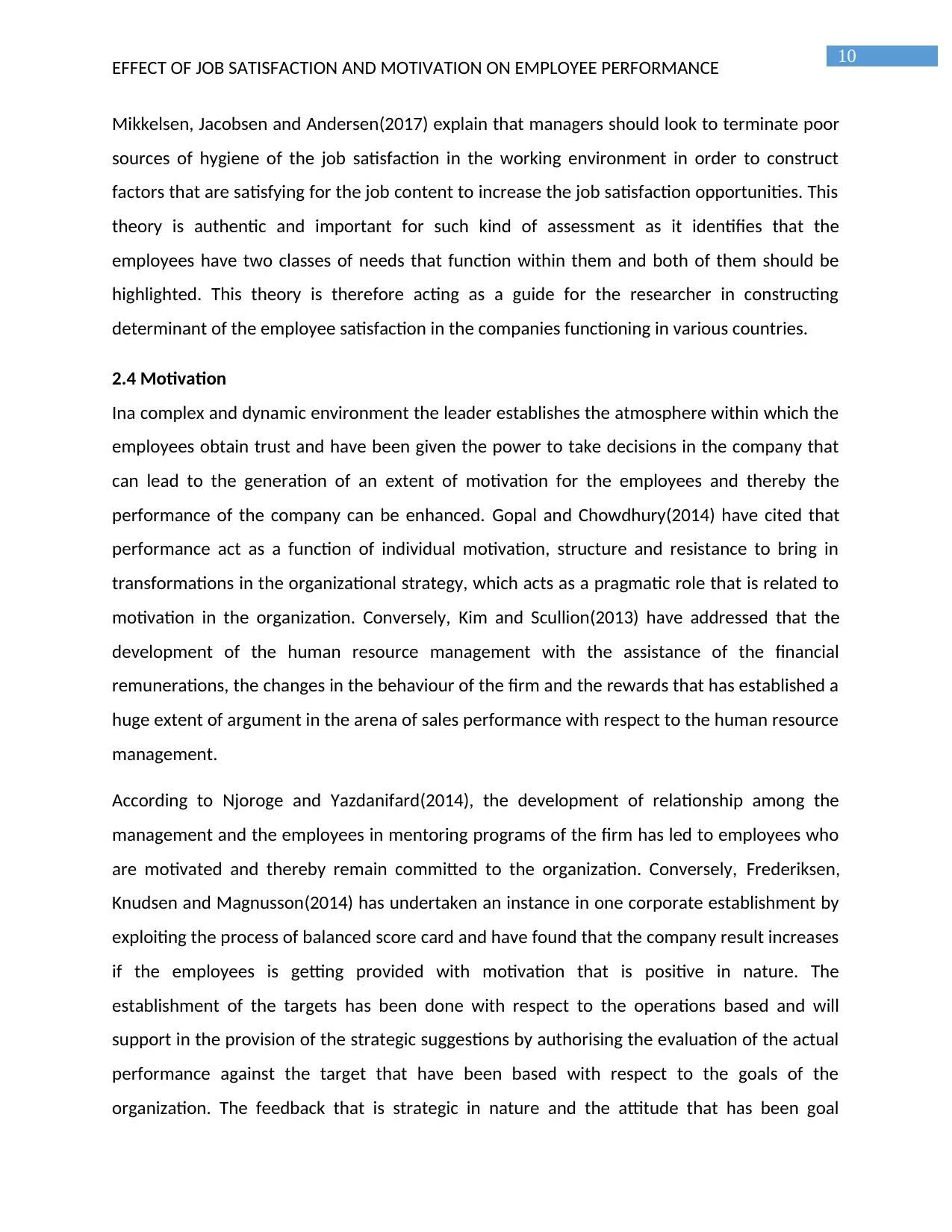
10
EFFECT OF JOB SATISFACTION AND MOTIVATION ON EMPLOYEE PERFORMANCE
Mikkelsen, Jacobsen and Andersen(2017) explain that managers should look to terminate poor
sources of hygiene of the job satisfaction in the working environment in order to construct
factors that are satisfying for the job content to increase the job satisfaction opportunities. This
theory is authentic and important for such kind of assessment as it identifies that the
employees have two classes of needs that function within them and both of them should be
highlighted. This theory is therefore acting as a guide for the researcher in constructing
determinant of the employee satisfaction in the companies functioning in various countries.
2.4 Motivation
Ina complex and dynamic environment the leader establishes the atmosphere within which the
employees obtain trust and have been given the power to take decisions in the company that
can lead to the generation of an extent of motivation for the employees and thereby the
performance of the company can be enhanced. Gopal and Chowdhury(2014) have cited that
performance act as a function of individual motivation, structure and resistance to bring in
transformations in the organizational strategy, which acts as a pragmatic role that is related to
motivation in the organization. Conversely, Kim and Scullion(2013) have addressed that the
development of the human resource management with the assistance of the financial
remunerations, the changes in the behaviour of the firm and the rewards that has established a
huge extent of argument in the arena of sales performance with respect to the human resource
management.
According to Njoroge and Yazdanifard(2014), the development of relationship among the
management and the employees in mentoring programs of the firm has led to employees who
are motivated and thereby remain committed to the organization. Conversely, Frederiksen,
Knudsen and Magnusson(2014) has undertaken an instance in one corporate establishment by
exploiting the process of balanced score card and have found that the company result increases
if the employees is getting provided with motivation that is positive in nature. The
establishment of the targets has been done with respect to the operations based and will
support in the provision of the strategic suggestions by authorising the evaluation of the actual
performance against the target that have been based with respect to the goals of the
organization. The feedback that is strategic in nature and the attitude that has been goal
EFFECT OF JOB SATISFACTION AND MOTIVATION ON EMPLOYEE PERFORMANCE
Mikkelsen, Jacobsen and Andersen(2017) explain that managers should look to terminate poor
sources of hygiene of the job satisfaction in the working environment in order to construct
factors that are satisfying for the job content to increase the job satisfaction opportunities. This
theory is authentic and important for such kind of assessment as it identifies that the
employees have two classes of needs that function within them and both of them should be
highlighted. This theory is therefore acting as a guide for the researcher in constructing
determinant of the employee satisfaction in the companies functioning in various countries.
2.4 Motivation
Ina complex and dynamic environment the leader establishes the atmosphere within which the
employees obtain trust and have been given the power to take decisions in the company that
can lead to the generation of an extent of motivation for the employees and thereby the
performance of the company can be enhanced. Gopal and Chowdhury(2014) have cited that
performance act as a function of individual motivation, structure and resistance to bring in
transformations in the organizational strategy, which acts as a pragmatic role that is related to
motivation in the organization. Conversely, Kim and Scullion(2013) have addressed that the
development of the human resource management with the assistance of the financial
remunerations, the changes in the behaviour of the firm and the rewards that has established a
huge extent of argument in the arena of sales performance with respect to the human resource
management.
According to Njoroge and Yazdanifard(2014), the development of relationship among the
management and the employees in mentoring programs of the firm has led to employees who
are motivated and thereby remain committed to the organization. Conversely, Frederiksen,
Knudsen and Magnusson(2014) has undertaken an instance in one corporate establishment by
exploiting the process of balanced score card and have found that the company result increases
if the employees is getting provided with motivation that is positive in nature. The
establishment of the targets has been done with respect to the operations based and will
support in the provision of the strategic suggestions by authorising the evaluation of the actual
performance against the target that have been based with respect to the goals of the
organization. The feedback that is strategic in nature and the attitude that has been goal
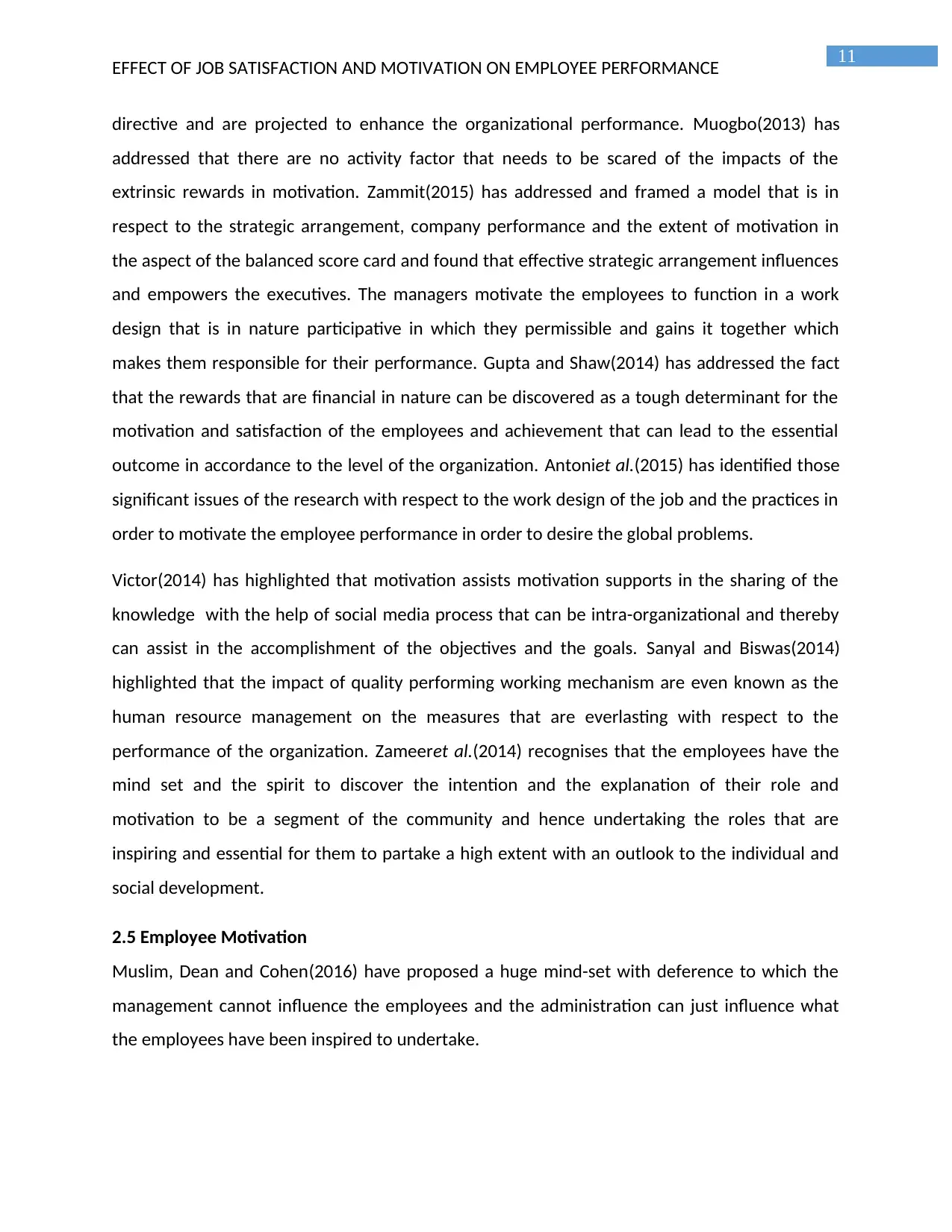
11
EFFECT OF JOB SATISFACTION AND MOTIVATION ON EMPLOYEE PERFORMANCE
directive and are projected to enhance the organizational performance. Muogbo(2013) has
addressed that there are no activity factor that needs to be scared of the impacts of the
extrinsic rewards in motivation. Zammit(2015) has addressed and framed a model that is in
respect to the strategic arrangement, company performance and the extent of motivation in
the aspect of the balanced score card and found that effective strategic arrangement influences
and empowers the executives. The managers motivate the employees to function in a work
design that is in nature participative in which they permissible and gains it together which
makes them responsible for their performance. Gupta and Shaw(2014) has addressed the fact
that the rewards that are financial in nature can be discovered as a tough determinant for the
motivation and satisfaction of the employees and achievement that can lead to the essential
outcome in accordance to the level of the organization. Antoniet al.(2015) has identified those
significant issues of the research with respect to the work design of the job and the practices in
order to motivate the employee performance in order to desire the global problems.
Victor(2014) has highlighted that motivation assists motivation supports in the sharing of the
knowledge with the help of social media process that can be intra-organizational and thereby
can assist in the accomplishment of the objectives and the goals. Sanyal and Biswas(2014)
highlighted that the impact of quality performing working mechanism are even known as the
human resource management on the measures that are everlasting with respect to the
performance of the organization. Zameeret al.(2014) recognises that the employees have the
mind set and the spirit to discover the intention and the explanation of their role and
motivation to be a segment of the community and hence undertaking the roles that are
inspiring and essential for them to partake a high extent with an outlook to the individual and
social development.
2.5 Employee Motivation
Muslim, Dean and Cohen(2016) have proposed a huge mind-set with deference to which the
management cannot influence the employees and the administration can just influence what
the employees have been inspired to undertake.
EFFECT OF JOB SATISFACTION AND MOTIVATION ON EMPLOYEE PERFORMANCE
directive and are projected to enhance the organizational performance. Muogbo(2013) has
addressed that there are no activity factor that needs to be scared of the impacts of the
extrinsic rewards in motivation. Zammit(2015) has addressed and framed a model that is in
respect to the strategic arrangement, company performance and the extent of motivation in
the aspect of the balanced score card and found that effective strategic arrangement influences
and empowers the executives. The managers motivate the employees to function in a work
design that is in nature participative in which they permissible and gains it together which
makes them responsible for their performance. Gupta and Shaw(2014) has addressed the fact
that the rewards that are financial in nature can be discovered as a tough determinant for the
motivation and satisfaction of the employees and achievement that can lead to the essential
outcome in accordance to the level of the organization. Antoniet al.(2015) has identified those
significant issues of the research with respect to the work design of the job and the practices in
order to motivate the employee performance in order to desire the global problems.
Victor(2014) has highlighted that motivation assists motivation supports in the sharing of the
knowledge with the help of social media process that can be intra-organizational and thereby
can assist in the accomplishment of the objectives and the goals. Sanyal and Biswas(2014)
highlighted that the impact of quality performing working mechanism are even known as the
human resource management on the measures that are everlasting with respect to the
performance of the organization. Zameeret al.(2014) recognises that the employees have the
mind set and the spirit to discover the intention and the explanation of their role and
motivation to be a segment of the community and hence undertaking the roles that are
inspiring and essential for them to partake a high extent with an outlook to the individual and
social development.
2.5 Employee Motivation
Muslim, Dean and Cohen(2016) have proposed a huge mind-set with deference to which the
management cannot influence the employees and the administration can just influence what
the employees have been inspired to undertake.
⊘ This is a preview!⊘
Do you want full access?
Subscribe today to unlock all pages.

Trusted by 1+ million students worldwide
1 out of 30
Related Documents
Your All-in-One AI-Powered Toolkit for Academic Success.
+13062052269
info@desklib.com
Available 24*7 on WhatsApp / Email
![[object Object]](/_next/static/media/star-bottom.7253800d.svg)
Unlock your academic potential
Copyright © 2020–2025 A2Z Services. All Rights Reserved. Developed and managed by ZUCOL.





